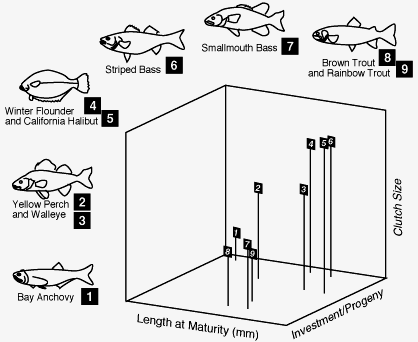


Relative positions of nine North American fish within
three-dimensional, life-history space illustrate substantial differences between species in length
at maturation, fecundity, and parental investment per progeny.

How can the self-regulating capabilities of fish populations be more effectively incorporated in assessments of the impacts of energy technologies on aquatic ecosystems?

Individual-based simulation modeling is a powerful tool for mechanistically exploring the potential for a fish population to compensate for environmental disturbances that increase mortality risk, decrease growth, and/or decrease reproduction.
As an example, life-history theory and results from individual-based models support the hypothesis that Age 0 smallmouth bass are likely to demonstrate a greater compensatory change in growth and mortality than Age 0 striped bass in response to environmental disturbances.
Some of the models from these studies have been used in regulatory proceedings to demonstrate that additional fish-protection measures may not be needed at specific power plants.

Van Winkle, W., K. A. Rose, and R. C. Chambers. 1993. Individual-based approach to fish population dynamics: An overview. Transactions of the American Fisheries Society 122:397-403.
Integrated Assessment Briefs. 1995. ORNL/M-4227. Oak Ridge National Laboratory, Oak Ridge, TN.